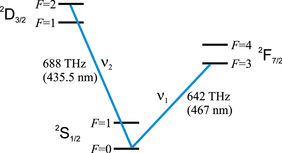In ongoing collaboration with physicists from Novosibirsk, we demonstrated a scheme to reduce the instability of the blackbody-radiation (BBR) shift in optical clocks to below 10−19. To achieve this, one has to combine at least two clock transitions with different BBR shift sensitivities to form a synthetic frequency standard. The linear combination of both constituents is chosen such that one achieves insensitivity to the BBR shift to first order in Temperature. As a specific example we study the case of the two clock transitions in the Yb+ ion shown in left. The scheme enables the realization of optical clocks that can be used outside laboratory conditions, where temperature fluctuations are much larger than in typical laboratories.
The publication can be found here.

